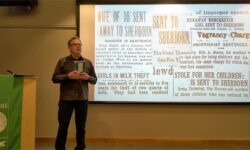[ccfic caption-text format="plaintext"]
By Stephen Press
Hometown Weekly Staff
Over a century ago, a Dover farmer and his wife generously set aside money for the construction of a new structure in the center of town. The structure, the Sawin Memorial Museum, was designed to house the Dover Historical and Natural History Society. It still stands today, and over the weekend, it was the focal point of a great celebration.
On Saturday, September 17, the reopening of the reimagined Sawin Museum provided the town with a reason to appreciate both its past and present. Champagne was sipped and speeches were given as the Museum received a steady stream of visitors.
Watching over the whole affair, Curator Stuart Swiny could not help but beam with pride.
"This is the apotheosis of a couple of years of work with the Assistant Curator, Pam Kunkemueller,” said Swiny. “She and I have worked ceaselessly to upgrade the display. It's very satisfying to see this come together."
"We've reorganized it; revisited it, so to speak,” he added. “For the past couple of years, we've been working on completely changing the interior and also remodeling the outdoors. We just finished a few weeks ago. There's nothing new about it except reorganizing what existed already inside, laying down a lot of gravel, leveling and generally beautifying what's outside."
Indeed, the Sawin looked ready for its close-up; the grounds were meticulously manicured and prepared, lending a greater air of dignity to the already-stately building.
"It's a fine building. It was built to stand out as an elite structure. Look at the roof, in fact," Swiny said, motioning towards the unique tiles that adorn the top of the Sawin. "They call it red slate. In fact, it's more purple. It's a kind of slate that was used for special buildings at the turn of the last century. In fact, Town Hall only has gray slate, so it's not as grand as this little building."
Of course, as is the case with many things, it’s what’s inside that counts. That maxim proves particularly true for the Museum, which houses an impressive collection.
"There's not any one object that stands out of over and above everything else,” said Swiny as he began to catalog the Sawin’s treasures.
"We have a very fine painting in there by Gilbert Stuart, no less, the man who gave the one dollar bill its image of Washington,” he explained. “We have a number of ever-smaller items. We have a musket, British-made in 1754. It was a Royal Marine musket. We know the British Royal Marines fought at Bunker Hill. There's an inscription, which is difficult to read, on the stock, and it mentions 'Hill.' I think it was taken off of a dead or dying British Marine and then used by the militiamen fighting against my ancestors. We have some very interesting Civil War artifacts; a rifle, incredibly well preserved. In fact, I was just asked 'Is that a copy?' It's well preserved."
This is all in addition to the museum’s reimagined basement, which houses a number of turn-of-the-Century artifacts dating back to the time of Benjamin Sawin himself. The farmer’s collection of planes, in fact, resides on the ground level, lovingly polished (with seven bottles of lemon oil, she’s quick to point out) by Lori Carbone.
"There are a lot of jewels,” Swiny added, but “there isn't one ruby in the center of the crown. There are a lot of diamonds around the crown, and that's the Sawin Museum."
As Dover’s residents filed in and out of the museum on Saturday, “ooh”-ing and “aah”-ing as they went, it was clear that the town was relishing this new opportunity to appreciate its lengthy history.
"It's part of the New England heritage," reflected Swiny. "European settlement goes back 350 years. It's quite a long time. There's a depth of history here, which you don't encounter as you go further west, of course. In this country, things are newer."
He then began to reflect again on the history of the museum itself.
"The fact that a local farmer should give this land - in fact, the so-called Sawin Triangle, several acres in the heart of Dover that was given to the society along with money to build the structure - it shows an acute appreciation for preserving the town's past, and having a space where citizens interested in history could meet,” Swiny said before taking another moment to contemplate the generosity of Benjamin and Eudora Sawin. “I’d like to think that they would be proud and pleased to see how alive the museum is today."
“This is quite a jewel, this museum,” he concluded.


























